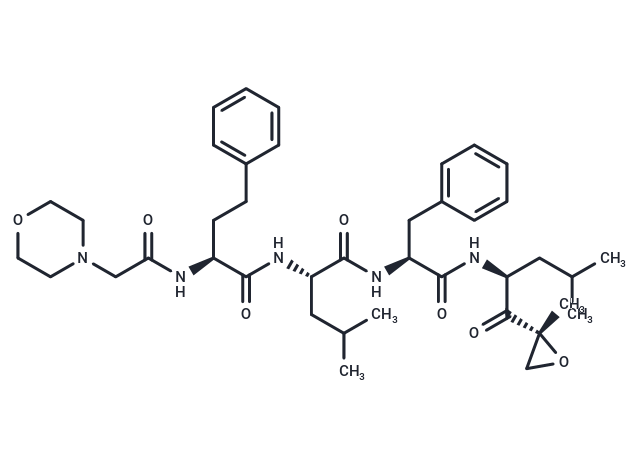Shopping Cart
Remove All Your shopping cart is currently empty
Your shopping cart is currently empty
Carfilzomib (PR-171) is a proteasome inhibitor that irreversibly binds to the chymotrypsin of the 20S proteasome. Carfilzomib has antitumor activity and may be used to treat multiple myeloma.

| Pack Size | Price | USA Warehouse | Global Warehouse | Quantity |
|---|---|---|---|---|
| 5 mg | $48 | In Stock | In Stock | |
| 10 mg | $68 | In Stock | In Stock | |
| 25 mg | $97 | In Stock | In Stock | |
| 50 mg | $139 | In Stock | In Stock | |
| 100 mg | $189 | In Stock | In Stock |
| Description | Carfilzomib (PR-171) is a proteasome inhibitor that irreversibly binds to the chymotrypsin of the 20S proteasome. Carfilzomib has antitumor activity and may be used to treat multiple myeloma. |
| Targets&IC50 | Proteasome:5 nM |
| In vitro | METHODS: Myeloma cell lines RPMI 8226 and ANBL-6 were treated with Carfilzomib (0-25 nM) for 24 h, and cell viability was measured using WST-1 assay. RESULTS: Carfilzomib treatment dose-dependently decreased the cell viability of RPMI 8226 and ANBL-6 cells, with IC50s of less than 5 nM. [1] METHODS: B-cell lymphoma cell lines Raji, Raji-2R and Raji-4RH were treated with Carfilzomib (1-10 nM) for 24-72 h. Apoptosis was analyzed using Flow Cytometry. RESULTS: Carfilzomib induced apoptosis in B-cell lymphoma cell lines and the extent of apoptosis was time dependent. [2] |
| In vivo | METHODS: To assay anti-tumor activity in vivo, Carfilzomib (5 mg/kg, 10% captisol) was injected intravenously twice weekly for five weeks into SCID mice bearing a mantle cell lymphoma (MCL) Mino. RESULTS: Carfilzomib virtually eliminated tumor growth and significantly prolonged the survival time of the tumor-bearing mice. [3] METHODS: To detect anti-tumor activity in vivo, Carfilzomib (6 mg/kg, 10% captisol) was administered intraperitoneally three times a week for three weeks to a mouse model of metastatic amorphous thyroid tumor (ATC). RESULTS: Carfilzomib treatment of mice with established extensive metastatic disease significantly improved their survival without significant toxicity. [4] |
| Kinase Assay | Enzyme-linked immunosorbent assay for subunit profiling of carfilzomib: ANBL-6 cells (2 × 106/well) are plated in 96-well plates and treated with Carfilzomib doses from 0.001 to 10 μM for 1 hour. Cells are then lysed (20 mM Tris-HCl, 0.5 mM EDTA), and cleared lysates are transferred to polymerase chain reaction (PCR) plates. A standard curve is generated using untreated ANBL-6 cell lysates starting at a concentration of 6 μg protein/μL. The active site probe [biotin-(CH2)4-Leu-Leu-Leu-epoxyketone; 20 μM] is added and incubated at room temperature for 1 hour. Cell lysates are then denatured by adding 1% sodium dodecyl sulfate (SDS) and heating to 100°C, followed by mixing with 20 μL per well streptavidin-sepharose high-performance beads in a 96-well multiscreen DV plate and incubated for 1 hour. These beads are then washed with enzyme-linked immunosorbent assay (ELISA) buffer (PBS, 1% bovine serum albumin, and 0.1% Tween-20), and incubated overnight at 4°C on a plate shaker with antibodies to proteasome subunits. Antibodies used included mouse monoclonal anti-β1, anti-β2, anti-β1i, and anti-β5i, goat polyclonal anti-β2i, and rabbit polyclonal anti-β5 (affinity-purified antiserum against KLH-CWIRVSSDNVADLHDKYS peptide). The beads are washed and incubated for 2 hours with horseradish peroxidase-conjugated secondary goat antirabbit, goat antimouse or rabbit antigoat antibodies. After washing, the beads are developed using the supersignal ELISA picochemiluminescence substrate. Luminescent detection is performed. Raw luminescence is converted to μg/mL by comparison with the standard curve and expressed as the % inhibition relative to vehicle control. Curve fits are generated using the following nonsigmoidal dose-response equation: Y = Bottom + (Top-Bottom)/(1 + 10?((LogEC50 ? X) × HillSlope)), where X is the logarithm of concentration, Y is the % inhibition, and EC50 is the dose showing 50% effect. |
| Cell Research | WST-1 is used to determine the effects of proteasome inhibitor Carfilzomib on cell proliferation. The inhibition of proliferation is calculated in relation to parallel control cells that receives vehicle alone. A linear spline function is used to interpolate the median inhibitory concentration (IC50) using XLfit 4 software. The degree of resistance (DOR) is calculated using the formula: DOR = IC50(resistant cells)/IC50(sensitive cells). ANBL-6 cells pulsed with 100 nM carfilzomib are washed and suspended in PBS containing 5 μg/mL of JC-1, which exhibits potential-dependent accumulation in mitochondria. Analysis of the mitochondrial membrane potential-dependent color shift from 525 to 590 nm is carried out on a FacScan, and the data are analyzed with CellQuest software.(Only for Reference) |
| Synonyms | PR-171 |
| Molecular Weight | 719.91 |
| Formula | C40H57N5O7 |
| Cas No. | 868540-17-4 |
| Smiles | CC(C)C[C@H](NC(=O)[C@H](CCc1ccccc1)NC(=O)CN1CCOCC1)C(=O)N[C@@H](Cc1ccccc1)C(=O)N[C@@H](CC(C)C)C(=O)[C@@]1(C)CO1 |
| Relative Density. | 1.162g/cm3 |
| Color | White |
| Appearance | Solid |
| Storage | keep away from direct sunlight | Powder: -20°C for 3 years | Shipping with blue ice/Shipping at ambient temperature. | |||||||||||||||||||||||||||||||||||
| Solubility Information | Ethanol: < 1 mg/mL (insoluble or slightly soluble) DMSO: 242 mg/mL (336.15 mM), Sonication is recommended. | |||||||||||||||||||||||||||||||||||
| In Vivo Formulation | 10% DMSO+40% PEG300+5% Tween 80+45% Saline: 5.5 mg/mL (7.64 mM), Suspension. Please add the solvents sequentially, clarifying the solution as much as possible before adding the next one. Dissolve by heating and/or sonication if necessary. Working solution is recommended to be prepared and used immediately. The formulation provided above is for reference purposes only. In vivo formulations may vary and should be modified based on specific experimental conditions. | |||||||||||||||||||||||||||||||||||
Solution Preparation Table | ||||||||||||||||||||||||||||||||||||
DMSO
| ||||||||||||||||||||||||||||||||||||
| Size | Quantity | Unit Price | Amount | Operation |
|---|

Copyright © 2015-2026 TargetMol Chemicals Inc. All Rights Reserved.